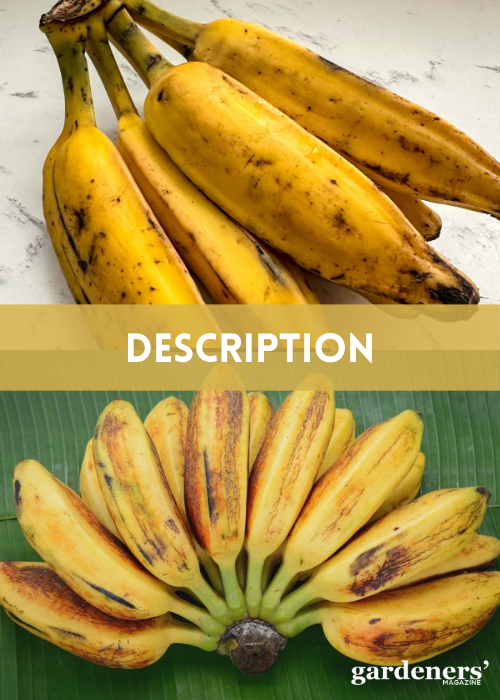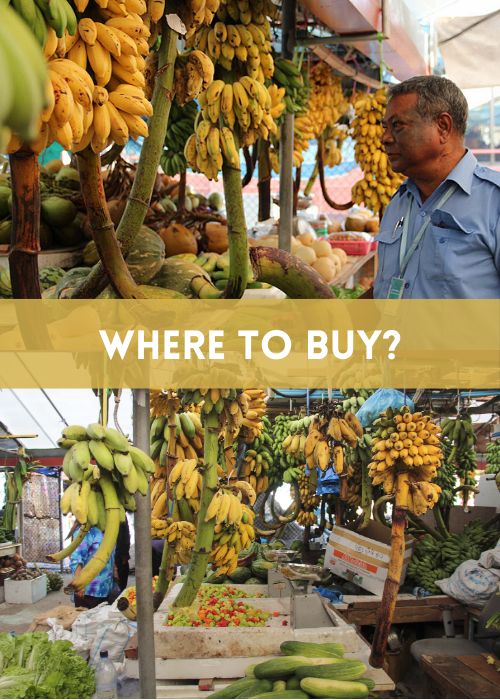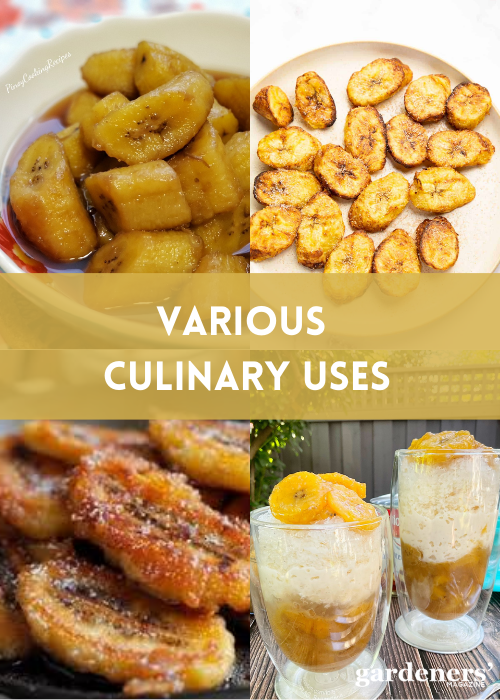The Saba banana is a form of hybrid banana that originated in Southeast Asia. They are native to Philippines and the entire plant is used for culinary purposes. Saba bananas are favored for their versatile nature, able to be eaten fresh or cooked. These plants grow year-round, providing a steady supply of fruits.
It can be enjoyed as a snack or used in various recipes such as desserts, beverages, salads, etc.
What is Saba Banana?

Saba bananas are a triploid hybrid ABB variety belonging to the Musaceae family. They are edible, sweet-tasting bananas with a distinct taste and texture. Their short, elongated shape, bright yellow color, and firm flesh make them stand out from other types of bananas. Their creamy texture and mild sweetness make them a great addition to desserts, beverages, salads, and more.
Saba bananas are available throughout the year and sold through roadside stands, local fresh markets, and select grocers. They are extensively planted in home gardens throughout the Philippines and Southeast Asia. Saba bananas are sometimes cultivated in Hawaii and Florida in the United States.
History and Origin of Saba Banana:
The Saba banana is believed to have originated in Philippines and has been around for centuries. The exact date of its origin is unknown, but it was first documented in 1773 by naturalist William Bligh. It was then brought to the United Kingdom, quickly gaining popularity for its delicious taste and versatility.
Saba banana in English, is often referred to as “Sweet plantain” or “Cardaba” banana. There are popular legends and folklore about this fruit being associated with a story of lost love, between a princess and a spirit.
Today, the Saba banana is grown and consumed in many parts of the world. Its also widely used in Southeast Asian cuisine as a unique way to add sweetness and texture to dishes.

Description of Saba Banana:
Saba bananas are angular, shorter, and thicker than the common variety of bananas. Raw ones often appear green in color and when ripened, turn to deeper yellow. They have thick skin with white, starchy, and firm flesh. It has a rich flavor profile with hints of sweetness, tang, and a starchy taste.
Saba bananas grow in large bunches, weighing around 30 kilograms per bunch. One banana is cylindrical in shape and averages 7 to 13 centimeters in length. The peels are tough and smooth with an elastic feel. The flesh is cream-colored, dense, and starchy and feels moist and meaty when bitten.
Where are They Grown?
Saba bananas are mostly grown in Indonesia and the Philippines. The Philippines is one of the main producers of Saba banana, with farmers growing it on a large scale for commercial purposes. Farmers in Indonesia also produce this type of banana to meet its global demand.
Saba bananas are grown in small sustainable farms in South Florida. Hawaii is the largest producer of Saba bananas in the United States.
Nutritional Benefits:
Saba bananas are considered a healthy snack or addition to any meal. They contain various vitamins and minerals, such as calcium, magnesium, potassium, iron, phosphorus, zinc, and vitamin C. When consumed raw, they pack the most nutrition.
Saba bananas are a good source of dietary fiber, which can help keep your digestive system healthy. They are also low in calories and have no fat content, making them a great snack for weight loss.

Flavor Profile:
The Saba banana has a unique flavor profile with its distinct sweetness, creaminess, and subtle citrus notes. It has a sweet and tangy flavor that is milder than other bananas and a smooth texture when ripe. This taste turns richer, savory and fruity when cooked.
The flavor also depends on the fruit’s ripeness; if it’s not quite ripe, it will have an astringent flavor. It is also used in various recipes to add sweetness and texture. Saba bananas are one of the most popular cooking bananas and is extensively versatile to be able to be eaten fresh or as addition to an array of sweet or savory preparations.

Where to Buy ?
The best quality Saba bananas are usually found in the produce section of local markets or specialty stores. When selecting a Saba banana, it is important to check for ripeness; it should be bright yellow and slightly soft when squeezed.
They are widely available across online delivery platforms like Instacart, Weee!, Quicklly and many more. Supermarket chains such as Walmart and Target has Saba bananas available most of the year.
If available, buying organic is also advisable to ensure you get the freshest and most nutritious fruit. You may find frozen Saba bananas in some stores that may last longer than fresh ones.

Cultivation
Saba bananas grow well in tropical climates, thriving in moderate to high humidity, which is necessary for good growth. They require 6-8 hours of direct sunlight daily, absence of which may negatively impact the fruit production.
Soil Preparation
- For successful growth, start with the right soil: well-draining soil that is rich in organic matter, which retains the moisture and nutrients.
- Enhancing your soil with compost, well-rotted manure. They help to boost soil fertility. Organic matter enriches the soil and also improves its moisture retention capabilities.
- Drainage is vital for preventing rotting and promoting healthy growth. Consider using raised beds or adding perlite to your potting mix. These techniques help ensure that excess water drains away, leading to a successful and healthy growth.
Planting Techniques:
- The best time to plant Saba bananas is in the spring but If you’re growing in containers, you have the flexibility to plant year-round, with the suitable climate.
- During plantation, keep the depth of 2 to 4 inches. For outdoor, space your banana plants 8 to 10 feet. If using containers, keep them 3 to 4 feet apart.
Water and Fertilizing:
- Keep the soil moist but avoid waterlogging. Water deeply once a week, and more oftenmduring hot weather to maintain optimal moisture levels.
- Fertilize every 6-8 weeks to support healthy growth. Regular feeding will help your Saba bananas reach their full potential. Organic fertilizers are preferentially better as they improve soil health and sustainable growth
Harvesting:
In order to harvest Saba bananas, look for plump, yellowish fruit. The ideal time for harvesting is when the bananas reach almost 60-80% maturity which is ideal for cooking.
Use sharp, clean shears to cut the banana clusters. They should be handled gengly to minimize bruising, and store them in a cool, dry place to maintain its freshness.
Post harvesting, store them in a well-ventilated area and avoid contamination and spoilage.
How to Store Saba Bananas?
Its best to store Saba bananas at room temperature, away from direct sunlight. Once ripe, they can be refrigerated for a few days to extend their shelf-life.
When frozen, they will last up to three months. However, when freezing Saba bananas, it is important to note that the texture and flavor will be compromised.
Its best to consume them when fresh.

Various Culinary Uses:
Saba bananas are incredibly versatile, making them a great addition to a variety of meals. They are often used in smoothies and shakes, baked into cakes and muffins, or enjoyed as a snack. Often cooked into savory dishes such as curries, stir-fries, and falafels. The leaves of the Saba banana can be used to wrap food for steaming or grilling.
Saba bananas are majorly cooked when the peels are still green. They can be battered and fried into a dish or boiled or steamed as a side dish. The bananas can also be cooked, sliced and served with syrup and caramelized sugar. They can be and topped with sugar, dried fruits, or nuts, or used into baked goods.
Saba bananas are famously used in Turon, a dessert where bananas are coated in sugar and fried to develop a caramelization. Saba bananas are used is for making ketchup, or banana sauce, an alternative to tomato ketchup. It constitutes of vinegar, spices, and sugar. It is often mixed with rice or served with meats or chicken.
Saba bananas go well alongside vanilla, brown sugar, caramel, aromatics, including onions and garlics, seafood, and meats such as chicken, beef and pork.
Conclusion:
Saba bananas are an incredibly nutritious and delicious fruit that can be enjoyed in various ways. They are a great energy source and essential vitamins and minerals, making them a great snack or addition to any meal. With proper storage and handling, you can ensure that your Saba bananas retain their freshness and flavor which can be further used to enhance your culinary world.
So go ahead and give them a try!
FAQ’s
Q.1 What is Saba banana?
Ans.- Saba bananas are hybrid bananas, originating from the Philippines. They have a thick skin with white, starchy and firm flesh. Saba fruit has a rich flavor profile with a sweet taste.
Q.2 When are Saba bananas ripe?
Ans.- They are ripe when they turn from green to yellow(with black spots).
Q.3 Where to buy Saba bananas near me?
Ans.- Saba bananas are available throughout the year, at roadside stands, supermarkets, farmers market and online stores.
Q.4 What does Saba banana taste like?
Ans.- They have a sweet and starchy taste when raw and develops a rich and savory flavor when cooked.
Q.5 How to cook Saba bananas?
Ans.- They are most commonly prepared are either fried, boiled, or processed into flour or dough.
- Everything You Wanted to Know About Red Tamarillos - June 2, 2025
- A Guide to Tulips: Everything You Need to Know & More… - June 2, 2025
- Guanabana: Description, Flavor, Benefits, And Uses - May 27, 2025

8 thoughts on “Saba Bananas: Description, History, Uses and More..”
Comments are closed.